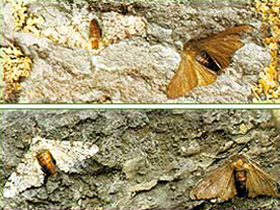Douglas Futuyma’s 1986 book Evolutionary Biology, is regarded as a reference that most clearly explains the theory of natural selection. The best-known of the examples cited by Futuyma is the darkening of the color of a moth population in Great Britain during the Industrial Revolution.
Before the Industrial Revolution began, the bark of trees in the Manchester area was light in color. Therefore, any dark-colored melanic moths landing on these trees were easily detected by birds and thus had little chance of survival. Fifty years of pollution later, however, the bark grew darker, after the death of the light-colored lichens on the trees, and now the lighter-colored moths fell prey to birds more often. As a result, as the number of light-colored moths declined, the dark-colored ones increased because they were less visible.
Evolutionists resort to the misleading claim that this process represents major evidence for evolution and that those lighter-colored moths gradually “evolved” into darker ones.
The fact is, though, this example cannot stand as evidence for evolution. The natural selection that took place did not give rise to the emergence of any new species that did not exist before. Black individuals already existed in the pre-Industrial Revolution population. All that changed was the characteristics of a species that already existed. Moths acquired no new organs or characteristics that would lead to species change. Whereas in order for a moth to turn into another distinct species, countless changes, additions and subtractions would have to occur in its genes. To put it another way, a whole new genetic program containing the physical characteristics of a new species would have to be loaded onto the moth.
Contrary to the impression evolutionists seek to give, it is impossible for natural selection to add or remove any organ from a living thing, and for that species to turn into another one. The strongest evidence on this subject since Darwin’s time is the tale of the peppered moths in Britain.
Yet there is an even more noteworthy aspect to the evolutionist “example” of the peppered moths. Not only is the interpretation of the story wrong, but so is the story itself. As the molecular biologist Jonathan Wells described in his 2000 book, Icons of Evolution, the reported tale of the Industrial-Revolution Moths does not reflect the true facts at all. (For detailed information, see The Evolution Deceit by Harun Yahya.)


